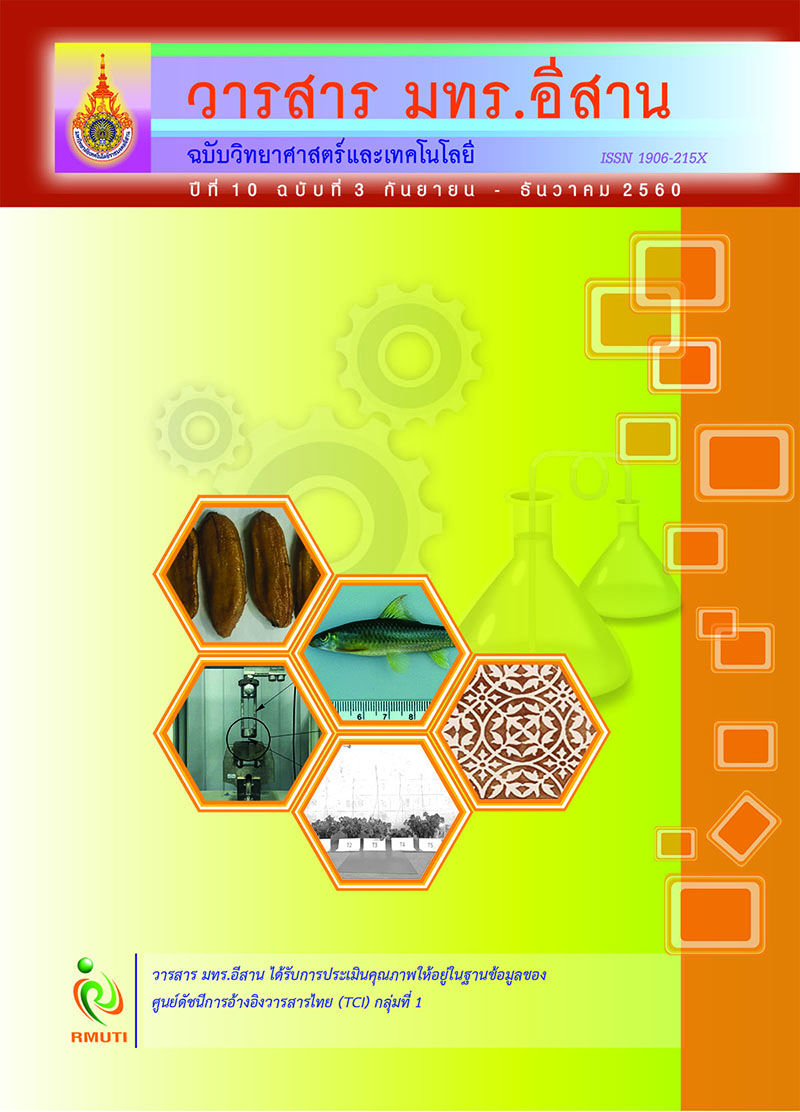ปัจจัยที่เหมาะสมในการดึงลวดเหล็กกล้าไร้สนิมที่มีผลต่อคุณภาพชิ้นงานสำเร็จ Stainless Wire Drawing Process Factors Affecting Finished Wire Quality
Main Article Content
Abstract
บทคัดย่อ
บทความนี้ ทำการศึกษากระบวนการดึงขึ้นรูปเหล็กกล้าไร้สนิม SUS304 โดยมุ่งเน้นศึกษาถึงผลกระทบของมุมไหลเข้าของแม่พิมพ์และความเร็วในการดึงขึ้นรูปที่ส่งผลต่อคุณภาพผิวและคุณสมบัติทางกลของเส้นลวดเหล็กกล้าไร้สนิม SUS304 ขนาดเส้นผ่านศูนย์กลางเส้นลวดก่อนการดึง 2 มิลลิเมตร ถูกดึงขึ้นรูปผ่านดายที่เคลือบผิวแข็งด้วย TiC ใช้สารหล่อลื่นชนิดนํ้ามันหล่อลื่น SAE40 ด้วยอัตราการลดลงของพื้นที่หน้าตัดร้อยละ 10 ขนาดมุมไหลเข้า (2) ของแม่พิมพ์มี 3 ขนาด คือ 16 18 และ 20o ดึงขึ้นรูปด้วยความเร็ว 4 ระดับ คือ 10 30 60 และ 90 มิลลิเมตรต่อนาที ตรวจสอบสมมุติฐานและวิเคราะห์ผล
จากแรงดึงขึ้นรูป ค่าความเรียบผิว ลักษณะพื้นผิว และคุณสมบัติทางกลของเส้นลวดก่อนและหลังการขึ้นรูปผลการทดลองพบว่า ความเรียบผิวเส้นลวดสำเร็จและแรงดึงขึ้นรูปเส้นลวดขึ้นอยู่กับปัจจัยหลัก คือขนาดมุมไหลเข้าของดาย ส่วนปัจจัยรองคือ ความเร็วในการดึงขึ้นรูป ซึ่งการดึงขึ้นรูปผ่านดายที่มีมุมไหลเข้าขนาดเล็กจะได้เส้นลวดที่มีพื้นผิวเรียบและมีความแข็งแรงดึงเพิ่มขึ้นสูง ส่วนการดึงขึ้นรูปผ่านดายที่มีขนาดมุมไหลเข้าขนาดใหญ่ได้เส้นลวดที่มีผิวหยาบ ปรากฏรอยแตกขนาดเล็กบนพื้นผิวลวด ความแข็งแรงดึงเพิ่มขึ้นน้อยกว่า และการดึงขึ้นรูปเส้นลวดด้วยความเร็วสูงจะได้เส้นลวดที่มีพื้นผิวเรียบและมีความแข็งแรงเพิ่มขึ้นมากกว่า แสดงให่เห็นว่าเงื่อนไขที่เหมาะสมในการดึงขึ้นรูปเส้นลวดเหล็กกล้าไร้สนิม คือ การเลือกใช้ดายที่มีมุมไหลเข้าขนาดเล็ก (16o) และทำการดึงขึ้นรูปด้วยความเร็วสูง (90 มิลลิเมตรต่อนาที) เพราะใช้แรงในการดึงขึ้นรูปค่อนข้างต่ำ พื้นผิวเส้นลวดสำเร็จมีแนวโน้มเรียบขึ้น และมีความแข็งแรงดึงเพิ่มขึ้นมากที่สุด
Abstract
This research aimed to investigate the influences of die approach angle and wire drawing speed on the performances of stainless steel wire drawing process. The specimen material used in the experiment was SUS304 Stainless steel wire, having the outer diameter of 2 mm. The die was TiC coating. The lubricant oil SAE 40 grade, were used in the experiment. The reduction ratio of the cross sectional area was set to be constant at 10 percentages. The die approach angle were 16, 18, and 20o, and the pulling speed was 10, 30, and 90 mm/min, respectively. The results of drawing forces, surface roughness, surface photography and tensile mechanical property of the drawn wires were recorded and analyzed. It was found from the results that in the drawing force and the wire surface roughness, based on, the main factor was die approach angle, and the minor factor is the drawing or pulling speed. From the results of the case of using lower die approach angle, the forces required were lower and the surface integrity of the wires was also lower than that of the larger die approach angle, the surface of the wires was also rough and micro cracks appear. And additional on high pulling speed, the surface of the wires is smoother and higher tensile strength. Further, the die with approach angle of 16o and pulling speed of 90 mm./min, provided the drawn wire with the best surface quality minimum drawing force and required maximum tensile strength.
Article Details
References
Vol. 79. pp. 60-67
[2] Shinohara T. and Yoshida K. (2005). Deformation Analysis of Surface Flaws in Stainless Steel Wire Drawing. Journal of Materials Processing Technology. Vol. 162. pp. 579-584. DOI: 10.1016/j.jmatprotec.2007.11.129
[3] Tourret R. (1955). The State of Lubrication in Wire Drawing Operation. Wire and Wire Products. Vol. 30. Nr 3. pp. 30-37
[4] Sadok L., Luksza J. and Majta J. (1994). Inhomogeneity of Mechanical Properties in Stainless Steel Rods After Srawing. Journal of Materials Processing Technology.
Vol. 44. Issue 1-2. pp. 129-141
[5] Cao T.S., Vachey C., Montmitonnet P. and Bouchard P.O. (2015). Comparison of Reduction Ability Between Multistage Cold Drawing and Rolling of Stainless Steel Wire - Experimental and Numerical Investigations of Damage. Journal of Materials Processing Technology. Vol. 217. pp. 30-47. DOI: 10.1016/j.jmatprotec.2014.10.020
[6] Suliga M. (2015). The Analysis of the High Speed Wire Drawing Process of High Carbon Steel Wire Under Hydrodynamic Lubrication Condition. Archives of Metallurgy and Materials. Vol. 60. Issue 1. pp. 403-408. DOI: 10.1515/amm-2015-0066
[7] Dalmau A., Rmili W., Richard C. and Igual-Mu oz A. (2016). Tribocorrosion Behavior of New Martensitic Stainless Steels in Sodium Chloride Solution. Wear. Vol. 368-369.
pp. 146-155
[8] Leonardo K., Simone T. and Gustavo M. (2009). The Influence of Die Geometry on Stress Distribution by Experimental and FEM Simulation on Electrolytic Copper Wire Drawing. Materials Research. Vol. 12. No. 3. DOI: 10.1590/S1516-14392009000300006
[9] Harish J. and Asim J. (2015). Dies Management in Wire Drawing Industry. Wire and Cable. Access (1 November 2014). Available (https://www.wirecable.in/2015/04/dies-management-in-wire-drawing-industry)
[10] Siebel E. and Kobitzsch R. (1943). Die Erwarmung Des Ziehgutes Bbeim Drahtziehen. Stahl Und Eisen. Vol. 63. pp. 110-113
[11] Lima-Filho A.D.P. (2003). A Wire Drawing Machine Design for Research and Experiment Teaching of Mechanical and Metallurgical Engineering Courses. In 17th International Congress of Mechanical Engineering. pp. 10-14
[12] Semiatin, S.L. (2005). Metalworking: Bulk Forming. ASM Handbook. Vol. 14.
[13] Vega G., Haddi A. and Imad A. (2009). Investigation of Process Parameters Effect on the Copper-Wire Drawing. Materials and Design. Vol. 30. pp. 3308-3312
[14] Kurt L. (1985). Handbook of Metal Forming. Society of Manufacturing Engineers. Dearborn, Michigan 481 21, USA.
[15] George E.D., Howard A.K., and Semiatin S.L. (2003). Handbook of Workability and Process Design. ASM International
[16] Tourret R. (1955). The State of Lubrication in Wire Drawing Operation. Wire and Wire Products. Vol. 30. pp. 30-37
[17] Ranaweera G. (2014). Theory of Wiredrawing. Access (1 November 2014). Available (https://www.antaac.org.mx/assets /10.-theory-of-wiredrawing.pdf)


